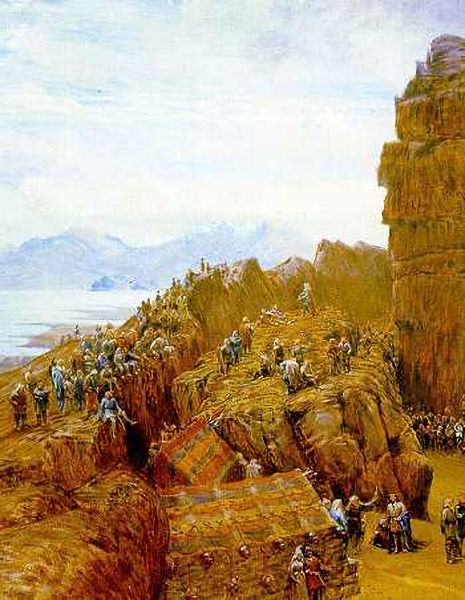Holmgang – Dangerous Viking Duel Settled Disputes
Ellen Lloyd - AncientPages.com - Like in any other ancient society, Norse people had to follow laws and rules, but there were often disputes, and sometimes people decided it was better to solve a matter through a challenge.
Egill Skallagrímsson engaging in Holmgang with Berg-Önundr, a painting by Johannes Flintoe. Credit: Public domain
It was done by a Holmgang, a duel that had to occur within three to seven days after the challenge was announced. Not showing up for the challenge was not a good idea.
If the person challenged did not show up for the Holmgang, then his opponent was considered the winner of the dispute by default. Not turning for a Holmgang caused shame to the entire clan. A person who decided not to participate in a Holmgang was deemed niðingr.
In modern days we would say a coward, but looking through the eyes of the Norse people, it was one of the worst things you could be called. It was a social stigma implying the loss of honor and the status of a villain. The result was that he could be sentenced to an outlaw.
 A Holmgang often resulted in death or severe injuries. Credit: Adobe Stock - alex_marina
A Holmgang often resulted in death or severe injuries. Credit: Adobe Stock - alex_marina
One of the most famous Viking outlaws was Erik the Red, a very controversial Viking. He was very violent, and his temper was beyond his control. It resulted in him being exiled from his country on two occasions!
As the Norse Sagas reveal, honor was significant in Norse society. A Holmgang could be called for in matters involving recognition, retribution, debt, legal disagreement, or intention to help a wife or relative or avenge a friend.
As previously discussed in Ancient Pages, Viking law and order was based on the Thing System. The ancient Viking society had a sophisticated government and law system, but talks and negotiations could not settle certain disputes. Some people demanded payment in blood. For example, in the case of a murder, relatives were expected to require a Holmgang. It often happened that a murder had been sentenced to death or banished from the country for some time, but relatives had the legal right to ask for a Holmgang. Anyone, regardless of social status, could be challenged in a Holmgang.
The Thing system was considered better than having disputes settled by duel or family feuds. In Viking society, all free men and women had the right to conduct revenge killings. Read more
Illustration - The Icelandic Althing in session, as imagined in the 1890s by British artist W. G. Collingwood. Credit: Public Domain
Holmgang can be translated as "to go to (or walk on) a small island." It is because the duel' took place upon a small piece of hiding or cloak placed on the ground. During the fight, the participants had to stay within the marked boundaries. The exact rules varied from place to place and changed over time, but before each challenge, the duelists agreed to the rules they used.
The oldest Holmgangs resulted in death battles or incapacitation of one combatant. Killing an opponent did not constitute murder and therefore did not lead to outlawry, and weregild ( a fine to the victim's family) was not required to be paid by the victor.
In 1006, Iceland declared Holmgangs were no longer allowed, and Norway outlawed the dangerous duel in 1014.
Updated on February 23, 2023
Written by - Ellen Lloyd – AncientPages.com
Copyright © AncientPages.com All rights reserved. This material may not be published, broadcast, rewritten or redistributed in whole or part without the express written permission of AncientPages.com
Expand for referencesMore From Ancient Pages
-
 Legendary Mount Penglai Where The Eight Immortals Reside
Chinese Mythology | Feb 20, 2018
Legendary Mount Penglai Where The Eight Immortals Reside
Chinese Mythology | Feb 20, 2018 -
 Secret Passageways And Caves Beneath Nottingham Castle
Featured Stories | Dec 6, 2015
Secret Passageways And Caves Beneath Nottingham Castle
Featured Stories | Dec 6, 2015 -
 Evidence Scots And Irish Settled Iceland A Century Before The Vikings?
Featured Stories | Jan 7, 2023
Evidence Scots And Irish Settled Iceland A Century Before The Vikings?
Featured Stories | Jan 7, 2023 -
 Syamantaka – Divine Jewel With Magical Powers Was A Gift From The Sun God In Hindu Mythology
Featured Stories | Mar 1, 2019
Syamantaka – Divine Jewel With Magical Powers Was A Gift From The Sun God In Hindu Mythology
Featured Stories | Mar 1, 2019 -
 4,500-Year-Old Sumerian Palace Discovered In The Ancient City Of Girsu
Archaeology | Feb 20, 2023
4,500-Year-Old Sumerian Palace Discovered In The Ancient City Of Girsu
Archaeology | Feb 20, 2023 -
 What Was The Agriculture Like In Southeast China In The Late Neolithic?
Archaeology | Apr 11, 2022
What Was The Agriculture Like In Southeast China In The Late Neolithic?
Archaeology | Apr 11, 2022 -
 Prehistoric Sime Skeleton And Now 15,000-Year-Old Bone Pendant Depicting ‘Venus’ Found In Vlakno Cave, Croatia
Archaeology | Dec 4, 2017
Prehistoric Sime Skeleton And Now 15,000-Year-Old Bone Pendant Depicting ‘Venus’ Found In Vlakno Cave, Croatia
Archaeology | Dec 4, 2017 -
 Did The Great Sphinx Of Giza Have A Twin And Was It Destroyed By A Lightning Strike?
Featured Stories | Dec 23, 2017
Did The Great Sphinx Of Giza Have A Twin And Was It Destroyed By A Lightning Strike?
Featured Stories | Dec 23, 2017 -
 Discovered Near Arctic: Mysterious Lost Medieval Civilization And Puzzling Ancient Mummy
Archaeology | Jul 4, 2015
Discovered Near Arctic: Mysterious Lost Medieval Civilization And Puzzling Ancient Mummy
Archaeology | Jul 4, 2015 -
 Three 3,500-Year-Old Painted Wooden Coffins Discovered In Luxor, Egypt
Archaeology | Dec 3, 2019
Three 3,500-Year-Old Painted Wooden Coffins Discovered In Luxor, Egypt
Archaeology | Dec 3, 2019 -
 Mystery Of Monte d’Accoddi: Was It An Ancient Step Pyramid, Altar Or Astronomical Observatory?
Civilizations | May 17, 2016
Mystery Of Monte d’Accoddi: Was It An Ancient Step Pyramid, Altar Or Astronomical Observatory?
Civilizations | May 17, 2016 -
 Who Said ‘Eureka’ First And Why?
Ancient History Facts | Feb 8, 2023
Who Said ‘Eureka’ First And Why?
Ancient History Facts | Feb 8, 2023 -
 Rare Bronze Hand Found At Roman Vindolanda
Archaeology | Jul 11, 2023
Rare Bronze Hand Found At Roman Vindolanda
Archaeology | Jul 11, 2023 -
 Ancient Egyptian Men Used Eye Makeup For Many Reasons
Ancient History Facts | May 9, 2016
Ancient Egyptian Men Used Eye Makeup For Many Reasons
Ancient History Facts | May 9, 2016 -
 Gungnir: Odin’s Magical Weapon That Provoked Or Reduced Conflicts In Norse Mythology
Featured Stories | May 12, 2020
Gungnir: Odin’s Magical Weapon That Provoked Or Reduced Conflicts In Norse Mythology
Featured Stories | May 12, 2020 -
 On This Day In History: Hubble Space Telescope Was Launched – On April 24, 1990
News | Apr 24, 2016
On This Day In History: Hubble Space Telescope Was Launched – On April 24, 1990
News | Apr 24, 2016 -
 85 Beautiful And Rare Coptic Textiles – A Gift To Museum At Queens College
Archaeology | Apr 4, 2017
85 Beautiful And Rare Coptic Textiles – A Gift To Museum At Queens College
Archaeology | Apr 4, 2017 -
 Science Fiction Was Around In Medieval Times – Here’s What It Looked Like
Featured Stories | Sep 18, 2018
Science Fiction Was Around In Medieval Times – Here’s What It Looked Like
Featured Stories | Sep 18, 2018 -
 Nammu: Sumerian Goddess Who Got The Idea To Create Mankind In The Image Of Gods
Featured Stories | Apr 1, 2019
Nammu: Sumerian Goddess Who Got The Idea To Create Mankind In The Image Of Gods
Featured Stories | Apr 1, 2019 -
 Troll Cross – Protection Symbol Believed To Ward Off Evil Powers
Ancient Symbols | May 12, 2018
Troll Cross – Protection Symbol Believed To Ward Off Evil Powers
Ancient Symbols | May 12, 2018


